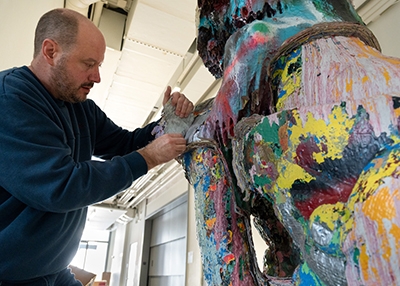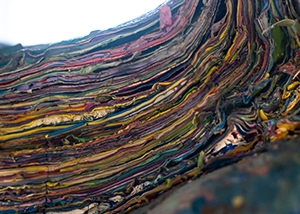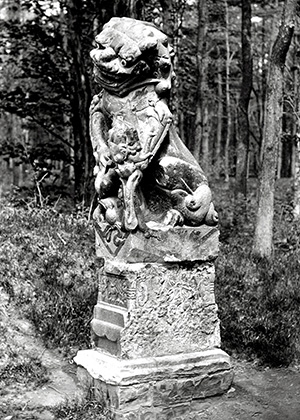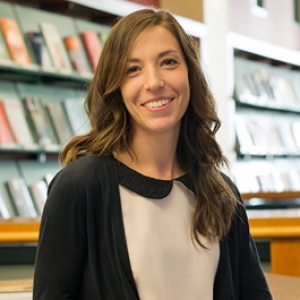Nestled incongruously on a wooded hillside in the Berkshires, a modern concrete and glass building serves as a hospital of sorts.
Among the patients at the Williamstown Art Conservation Center: the College’s Chinese stone lion. The sculpture once known as the Idol had been the target of hundreds of student paint pranks over nearly a century and a half.
Conservators in Williamstown are working apace to remove the paint layers in a meticulous process of gently heating and peeling. Most of the bottom half of the two-ton, 7-foot sculpture is free of all but the first layers of paint, which is more than two inches thick in some places.
Conservators expect to reach the original marble surface in the spring, when they will evaluate the piece and take measures to stabilize it for indoor display. Plans are to place the restored Chinese stone lion in the ground floor lobby connecting the Peter Irving Wold Center and F.W. Olin Center.
“We’re excited to see the progress in restoring this important piece of Chinese culture,” said Frances Maloy, College librarian and committee chair. She joined Sarah Mottalini, curatorial assistant, on a recent visit to the art restoration center. “We look forward to placing it where it can be appreciated as an important part of our collection.
“We are indebted to the collective expertise of the committee helping with this multi-faceted project,” Maloy added. Members include Sheri Lullo, associate professor of art history and director of Asian Studies; Joy Wang, associate professor of mathematics; Marc Donovan, director of facilities; Danny Duque, facilities project manager; Greta Donato, director of academic planning and finance; and Daniel Wilcox, presidential fellow.”
The original sculpture depicted a mother lioness with bulging eyes, her mouth agape as a long mane drapes her body. She stands upright, head slightly tilted down to her left toward a young cub who playfully balances at her feet on a small ball.
The sculpture was replaced last year by a “Block U” on a rise just west of Achilles Center, where the painting tradition continues.
The Chinese stone lion sculpture was last cleaned of paint around 2005, according to Marc Donovan, director of facilities and campus development.
Professor Lullo specializes in the art and archaeology of ancient China. Her article on Union’s Chinese stone lion, “From Lion to ‘Idol’” appears in a recent issue of Orientations, a scholarly journal on Asian art.
A gift from the Rev. John Farnham, Class of 1856, the “Idol” had been targeted with paint since it was set up at Union in 1876. Farnham, a missionary in China, purchased the statue after it was unearthed during a construction project in Shanghai. Before he shipped it to Union, he had placed it for a time in front of the nearby boys school he ran there.
Also undergoing restoration at the WACC are the full-length portrait of Eliphalet Nott by Henry Inman that hangs in the Nott Memorial, and several of the College’s geometrical string models by 19th-century French geometer Théodore Olivier.





